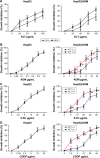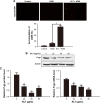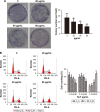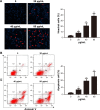Kanglaite reverses multidrug resistance of HCC by inducing apoptosis and cell cycle arrest via PI3K/AKT pathway
- PMID: 29520149
- PMCID: PMC5833758
- DOI: 10.2147/OTT.S153814
Kanglaite reverses multidrug resistance of HCC by inducing apoptosis and cell cycle arrest via PI3K/AKT pathway
Retraction in
-
Kanglaite Reverses Multidrug Resistance of HCC by Inducing Apoptosis and Cell Cycle Arrest via PI3K/AKT Pathway [Retraction].Onco Targets Ther. 2024 Feb 13;17:99-100. doi: 10.2147/OTT.S463641. eCollection 2024. Onco Targets Ther. 2024. PMID: 38371878 Free PMC article.
Abstract
Background: Multidrug resistance (MDR) frequently contributes to the failure of chemotherapeutic treatments in patients diagnosed with hepatocellular carcinoma (HCC). Revealing the molecular mechanism of MDR is indispensable for the development of effective chemotherapeutic drugs.
Purpose: Due to the low-toxicity modulators to inhibit MDR, we considered that Kanglaite (KLT) is a potential agent for reversing MDR in HCC.
Materials and methods: BEL-7402/5-fluorouracil (5-FU) and HepG2/adriamycin (ADM) were analyzed for cell viability, colony formation assay, cell scratch assay, and cell cycle analysis and apoptosis assay by flow cytometry. The expression of PARP, caspase-3, Bax, Bcl-2, CDC25C, Cyclin B1 and phosphorylation of PTEN, PI3K, and AKT in HepG2/ADM cells were detected by western blotting.
Results: The proliferation of drug-resistant cell lines BEL-7402/5-FU and HepG2/ADM pretreated with KLT was significantly inhibited when compared with drug alone. KLT could increase the accumulation of ADM in HepG2/ADM cells. In this study, we found that KLT treatment notably reduced cell viability, induced apoptosis and cell cycle arrest in human HepG2/ADM and BEL-7402/5-FU cells, and effectively reversed the MDR by p-glycoprotein (P-gp) inhibition. Moreover, KLT decreased the phosphorylation of AKT and PI3K in KLT-treated HepG2/ADM cells. These data together implied that KLT might reverse drug resistance in HCC by blocking the PI3K/AKT signaling.
Conclusion: We demonstrated that KLT reversed MDR of human HCC by inducing apoptosis and cell cycle arrest via the PI3K/AKT signaling pathway.
Keywords: PI3K/AKT pathway; apoptosis; hepatocellular carcinoma; kanglaite; multidrug resistance.
Conflict of interest statement
Disclosure The authors declare no conflict of interest.
Figures







Similar articles
-
Kanglaite enhances the efficacy of cisplatin in suppression of hepatocellular carcinoma via inhibiting CKLF1 mediated NF-κB pathway and regulating transporter mediated drug efflux.J Ethnopharmacol. 2021 Jan 10;264:113388. doi: 10.1016/j.jep.2020.113388. Epub 2020 Sep 10. J Ethnopharmacol. 2021. PMID: 32918990
-
Reversal effect of bufalin on multidrug resistance in human hepatocellular carcinoma BEL-7402/5-FU cells.Oncol Rep. 2014 Jan;31(1):216-22. doi: 10.3892/or.2013.2817. Epub 2013 Oct 24. Oncol Rep. 2014. PMID: 24173654
-
Aloperine induces apoptosis and G2/M cell cycle arrest in hepatocellular carcinoma cells through the PI3K/Akt signaling pathway.Phytomedicine. 2019 Aug;61:152843. doi: 10.1016/j.phymed.2019.152843. Epub 2019 Jan 28. Phytomedicine. 2019. PMID: 31039533
-
Timosaponin A-III reverses multi-drug resistance in human chronic myelogenous leukemia K562/ADM cells via downregulation of MDR1 and MRP1 expression by inhibiting PI3K/Akt signaling pathway.Int J Oncol. 2016 May;48(5):2063-70. doi: 10.3892/ijo.2016.3423. Epub 2016 Mar 7. Int J Oncol. 2016. PMID: 26984633
-
Down-regulation of extracellular signal-regulated kinase 1/2 activity in P-glycoprotein-mediated multidrug resistant hepatocellular carcinoma cells.World J Gastroenterol. 2009 Mar 28;15(12):1443-51. doi: 10.3748/wjg.15.1443. World J Gastroenterol. 2009. PMID: 19322916 Free PMC article.
Cited by
-
LncRNA H19 overexpression induces bortezomib resistance in multiple myeloma by targeting MCL-1 via miR-29b-3p.Cell Death Dis. 2019 Feb 6;10(2):106. doi: 10.1038/s41419-018-1219-0. Cell Death Dis. 2019. PMID: 30728351 Free PMC article.
-
Bioinformatics analysis of different candidate genes involved in hepatocellular carcinoma induced by HepG2 cells or tumor cells of patients.J Int Med Res. 2020 Jun;48(6):300060520932112. doi: 10.1177/0300060520932112. J Int Med Res. 2020. PMID: 32567431 Free PMC article.
-
Evaluation of Efficacy and Safety for Kanglaite Injection in the Control of the Malignant Pleural Effusions via Thoracic Perfusion: A Systematic Review and Meta-Analysis of Randomized Controlled Trials.Front Pharmacol. 2021 Nov 3;12:694129. doi: 10.3389/fphar.2021.694129. eCollection 2021. Front Pharmacol. 2021. PMID: 34803667 Free PMC article. Review.
-
Advances in the role of microRNAs associated with the PI3K/AKT signaling pathway in lung cancer.Front Oncol. 2023 Dec 19;13:1279822. doi: 10.3389/fonc.2023.1279822. eCollection 2023. Front Oncol. 2023. PMID: 38169723 Free PMC article. Review.
-
Efficacy and safety of Kanglaite injection combined with chemotherapy for colorectal cancer: A protocol for systematic review and meta-analysis.Medicine (Baltimore). 2020 Sep 25;99(39):e22357. doi: 10.1097/MD.0000000000022357. Medicine (Baltimore). 2020. PMID: 32991451 Free PMC article.
References
-
- Torre LA, Bray F, Siegel RL, Ferlay J, Lortet-Tieulent J, Jemal A. Global cancer statistics, 2012. CA Cancer J Clin. 2015;65(2):87–108. - PubMed
-
- Lotz C, Kelleher DK, Gassner B, Gekle M, Vaupel P, Thews O. Role of the tumor microenvironment in the activity and expression of the p-glycoprotein in human colon carcinoma cells. Oncol Rep. 2007;17(1):239–244. - PubMed
Publication types
LinkOut - more resources
Full Text Sources
Other Literature Sources
Research Materials
Miscellaneous

